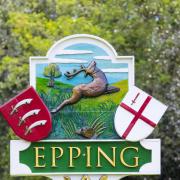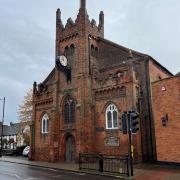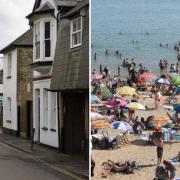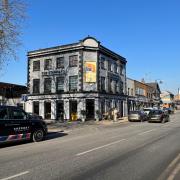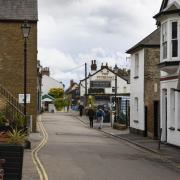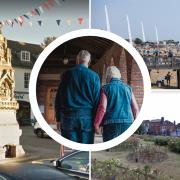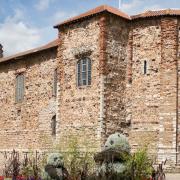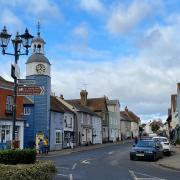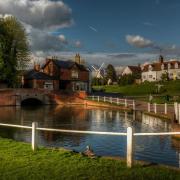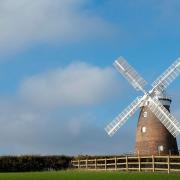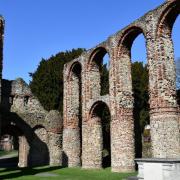In 1953, residents of Braintree queued outside the town's Warner Silk Mill to see the making of a beautiful silk for the Queen's coronation. Now this silk has been
chosen as one of our county's most historic objects, writes Nicky Adams
Braintree - a history in the making
SUMPTUOUS in blue silk with gold thread and depicting the emblems of England, Ireland, Scotland and Wales, the Coronation Silk hung in pride of place from the balconies of Westminster Abbey and from the royal box as a backdrop to the crowning of Queen Elizabeth II on June 2, 1953. It was designed by Robert Godden, who was then rector of the Royal College of Art in London, and was woven by Warner and Sons Ltd in Braintree, which had been making silks and velvets for royal occasions and households since the reign of Queen Victoria.
To this day, this historic 50-inch wide silk, cotton, rayon and lurex fabric is still intact and is held as part of the collection of the Warner Textile Archive in Braintree. So when the BBC came knocking to ask for objects to be included in its ground-breaking History of the World project, it was an obvious suggestion. To the delight of the guardians of Braintree’s museums, the Coronation Silk was chosen along with ten other objects from collections across Essex to help tell a history of the county and its place in the world.
‘It’s wonderful that one of the important royal fabrics from the Warner Textile Archive has been recognised nationally,’ says Cllr Tim Wilkinson, deputy portfolio holder for enterprise and culture at Braintree District Council. ‘It really shows the high level of skill local weavers from Braintree’s Warner and Sons had in the 1950s.’
Indeed it is an honour to be selected for History of the World, which is a partnership between the BBC and the British Museum and 350 museums and institutions across the country to find the most important manufactured objects ever made in our country, from flints to mobile phones.
The Coronation Silk was chosen along with ten other objects from collections across Essex to help tell a history of the county and its place in the world
Right at the heart of the project is the BBC Radio 4 series A History of the World in 100 Objects, written and narrated by Neil MacGregor, director of the British Museum, which travels through two million years to retell the history of humanity through the objects that have been made. Inspired by the 100-programme series, museums around the country have teamed up with the BBC in their areas and chosen more than 600 objects from their own collections that reflect world history from each area’s perspective.
‘A truly fascinating range of objects has been chosen for each list across English regions,’ says BBC project manager for the nations and English regions, Seamus Boyd. ‘Some of them may have great monetary value, others little or none, but they’re priceless in how they bring to life moments from history.’
Along with the Coronation Silk, Essex has contributed several other objects of historic importance that are shown on the BBC’s website. A Viking necklace has been contributed by Saffron Walden Museum, The Marconi broadcasting hut by Sandford Mill in Chelmsford, a tow rope from Endeavour I by Mersea Island Museum and the Ekco round radio by Southend Museums.
The Coronation Silk can be seen at the Braintree District Museum in Manor Street, however there are many other examples of locally-produced textiles at Warner Textile Archive at Warner’s Mill in Silks Way. As well as this important fabric, this nationally-important archive holds an example of almost every woven and printed fabric ever produced by the Warner company, plus original pieces of artwork by leading designers that were commissioned to furnish palaces, stately homes, liners, hotels and domestic homes.
It’s a unique record of the history of textile manufacture and design since the 18th century and many fabrics are on display to the public in The Gallery, which is open three days a week. From Warner’s unique three-pile velvets to the intricate woven silks of Owen Jones and the cutting-edge designs of the 1920s and 1930s through to the boldness of the 1950s and the iconic creations of the late 20th century, the display cases and drawers are full of historic textiles that demonstrate the rich heritage of textile production in Braintree.
Words on Warner
Warner and Sons was founded in 1870 as Warner, Sillet & Ramm by Benjamin Warner (1828-1908) to take advantage of the negative effect of the Franco-Prussian war on the French silk industry. The Warner family had been involved in the silk industry since the 17th century, manufacturing traditional patterns. However, Benjamin Warner was very interested in contemporary design and bought designs from the renowned and influential designer Owen Jones. The firm supplied Liberty & Co, Collinson & Lock and Debenham & Freebody. The company moved to Braintree in 1895, having taken over buildings already used in the silk industry, and specialised in high-quality textiles, supplying fabrics for royal ceremonies for King George VI and the Prince of Wales as well as the Queen’s coronation. The company ceased weaving in Braintree in 1971, but examples of fabrics produced there are held at the Warner Textile Archive.
See for yourselfThe Gallery at Warner Textile Archive, Warner’s Mill, Silks Way in Braintree is open 11am to 4pm, Wednesday to Friday (closed Saturday to Tuesday and Bank Holidays). Admission costs �3 for adults and �1.50 for concessions (including people with disabilities). Children are admitted free when accompanied by a paying adult. For more information call 01376 557741.
Braintree District Museum in Manor Street, Braintree, is open Monday to Saturday from 10am until 5pm. There is a �3 admission charge for adults, �1.50 concessions and children are free. For more details call 01376 325266.



